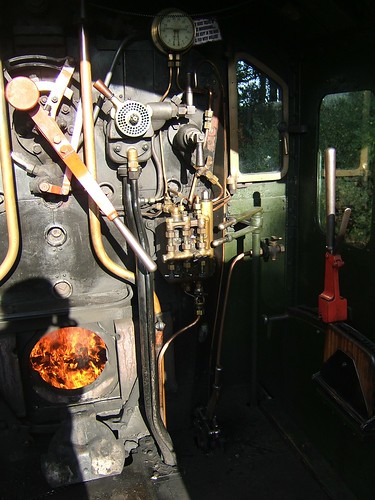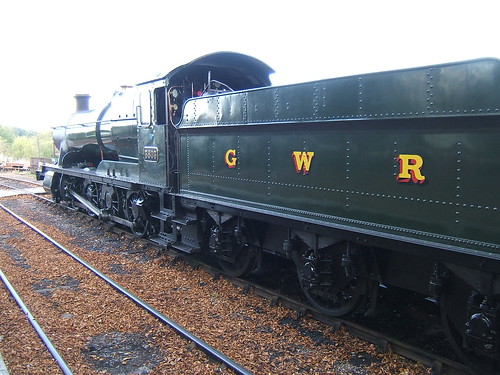Saturday, 9th June 2012

Peppa Pig (Image: Daily Telegraph).
The Battlefield Line had a 'Peppa Pig' weekend on the 9th and 10th June 2010. Although I know that Peppa Pig is very popular with children, it's not an area I'm familiar with (if, like me, you need more background, I suggest consulting the Wikipedia article).
Despite my ignorance of the Peppa Pig canon, I was happy to be rostered to drive the diesel railcar on Saturday 9th. I was not surprised that the diesel railcar was not, in fact, required but I was asked, instead, to be driver on '3803' for five round trips to Shenton with a 4-coach train incorporating a buffer car.
I turned up, bright and early, at the same time as Dave. '3803' was in the shed and a decent warming fire had been put in on Friday so the boiler was still nice and warm. Adrian performed the rather dusty job of emptying the contents of the ashpan into the pit, using a hose to help lay the dust and ensure that the ashpan was properly cleared. Dave and I broke up a pallet for firewood and then Dave set to making up the fire whilst I started oiling round.
There are always plenty of oiling points to attend to on a Great Western locomotive but they are much easier to get at on '3803' than, for instance, on the four cylinder Great Western designs where there are two sets of Walschaerts motion crammed between the frames. I described some of the features of this 2-8-0 class in the earlier article Summer Saturday with a '2884'.
Having given us a good start, Adrian went down to Market Bosworth by road to check on arrangements there. The Peppa Pig activities had been advertised as taking place at Shackerstone but the weather forecast for the day was poor so it had been decided to move the activities to Market Bosworth where the large goods shed provided a suitable covered area, should the weather deteriorate. In fact, we only received a few spots of rain during the whole day but Market Bosworth station and yard formed an excellent 'base' for the scheduled performances by the Peppa Pig characters.
Eventually, I completed my oiling and examination of the locomotive (ending up fairly liberally covered in oil myself. By this time, Dave had the boiler pressure increasing nicely. Although Dave had had the water hose in the tender tank throughout preparation, we'd not reached a comfortable level so we decided to come 'off-shed' at about 10.30, giving us plenty of time to water at the column at the end of platform 2 before going onto the coaching stock.

The driving controls on '3803'.
We gently came off shed and the signalman turned us across to Platform 2 to reach the water column. A red flag was displayed on the end coach (locally used to indicate staff working in the 'six-foot', filling the lavatory tanks or dealing with underbody mounted equipment on the buffet car) so we had to 'stand off' until it had been removed. We could not start watering whilst 'standing off' because the tender water filler was not yet within reach of the rotating arm carrying the water 'bag'. Once the flag was removed and the Guard called us on, we moved forward and, with the loco buffers just touching the stock, we were able to fill the 3,000 gallon tender.
With a full tender tank, the engine was 'tied on' and, in good time, we were able to 'blow up' (create vacuum), allowing the guard to carry out a brake test. However, booked departure time (11.15) came and went as passengers continued to board. Firemen will usually attempt to have full pressure available at the start of a run with a fairly full boiler, leaving a little space so that more water can be added to prevent blowing off if departure is delayed. It's equally important not to over-fill the boiler at this stage as, particularly with a large, piston-valve engine like '3803', undesirable 'priming' may occur when the train moves away as water gets carried over into the cylinders along with the steam. The fireman can seek to lower the rate of steam generation by closing the dampers (reducing 'Primary Air') and opening the firehole doors (increasing 'Secondary Air'), cooling the fire. However, some discharge of steam from the safety valves may be unavoidable.
Eventually, the Guard gave the 'Rightaway' and we set off, tender first, with the cylinder drain cocks open resulting in the front of the engine being wreathed in steam. Having 'purged' any condensate from the cylinders, the cylinder drain cocks were closed (by releasing the latch with one foot).
I've talked about driving '3803' in the earlier article describing the Santa Specials.
The Line Speed Limit is only 25 m.p.h. but parts of the line have lower limits (applicable in both directions of travel), which makes driving interesting. The present limits are shown belo:-
| Location | Speed m.p.h. |
| Shackerstone Station Platforms 1 and 2 to Signal Box | 5 |
| Shackerstone Signal Box to Barton Lane overbridge 32 | 10 |
| Adjacent Headley's Crossing (Relaid track) | 10 |
| Market Bosworth Station (Bridge 27 to Signal Box) | 10 |
| Adjacent Underbridge 26 | 5 |
| Shenton Station Ground Frame to buffer stop | 5 |
 '3803' standing at the north end of Platform 2 at Shackerstone.
'3803' standing at the north end of Platform 2 at Shackerstone.
On the first round trip I managed to lose time, and I was told, in no uncertain terms, to 'pick up the pace'. By driving somewhat harder than normal, I managed to achieve 'even time' on later trips. Adrian drove the third trip and fired the fourth trip. We'd been quite busy during the day but our final departure at 4.15 p.m. seemed a little quieter. Arrival back at Shackerstone was very close to 'right time'.
We trundled back to the shed light engine, pausing outside the shed to clean the fire. Dave had 'run down' the fire just right and not much work with fire irons was needed to knock the ash through the firebars into the ashpan where it would be left overnight, to be raked out the next morning. Boiler pressure was sufficient to move inside the shed and 'tie her down' whilst the injector filled the boiler.
An excellent, if tiring, day.
The following day, I was back on the footplate, on a smaller engine. That day is described in A Day on the Footplate (2).
Patients waiting for treatment at the Bagan Clinic (Photo: Dr. Hla Tun).
Following treatment, a group of patients depart for home (Photo: Dr. Hla Tun).



